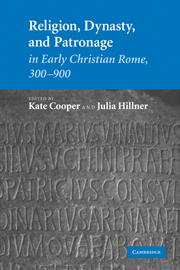Book contents
- Frontmatter
- Contents
- Acknowledgements
- List of contributors
- Abbreviations
- Introduction
- PART I ICONS OF AUTHORITY: POPE AND EMPEROR
- PART II LAY, CLERICAL, AND ASCETIC CONTEXTS FOR THE ROMAN GESTA MARTYRUM
- 3 Domestic conversions: households and bishops in the late antique ‘papal legends’
- 4 Agnes and Constantia: domesticity and cult patronage in the Passion of Agnes
- 5 ‘A church in the house of the saints’: property and power in the Passion of John and Paul
- PART III RELIGION, DYNASTY, AND PATRONAGE
- Bibliography
- Index
5 - ‘A church in the house of the saints’: property and power in the Passion of John and Paul
Published online by Cambridge University Press: 02 October 2009
- Frontmatter
- Contents
- Acknowledgements
- List of contributors
- Abbreviations
- Introduction
- PART I ICONS OF AUTHORITY: POPE AND EMPEROR
- PART II LAY, CLERICAL, AND ASCETIC CONTEXTS FOR THE ROMAN GESTA MARTYRUM
- 3 Domestic conversions: households and bishops in the late antique ‘papal legends’
- 4 Agnes and Constantia: domesticity and cult patronage in the Passion of Agnes
- 5 ‘A church in the house of the saints’: property and power in the Passion of John and Paul
- PART III RELIGION, DYNASTY, AND PATRONAGE
- Bibliography
- Index
Summary
On the Monte Celio, the transformation of Rome from late ancient to medieval city appears to unfold before our eyes. A short walk from the Colosseum takes one to the Clivus Scauri, an exquisitely preserved Roman street running up the hill, and to the formidable redoubt of Christian monuments built around it. To one side, the monastery of S. Gregorio, founded by Gregory the Great on his own property, and its satellite chapels. Immediately adjacent is the so-called ‘bibliotheca Agapeti’, a reminder of the Christian university planned by Pope Agapetus. Behind this cluster, on the eastern slope of the hill, is the Lateran Palace, commissioned by the emperor Constantine in the fourth century, and the regular residence of popes from the seventh. Archaeologists are now persuaded that Constantine's palatial development was accompanied by interest in the neighbourhood from the most powerful private investors in the city, the Anicians. By 400, the dynasty was well established there, having converted shops and houses into a massive residential complex – the direct or indirect parent of the papal stronghold that took shape in the sixth century.
The shift from private mansion to ecclesiastical redoubt seems still more powerfully enacted on the other side of the Clivus Scauri, in the church of SS. Giovanni e Paolo. According to their passio, John and Paul were executed in the reign of Julian the Apostate (361–363), and buried in their house; under the sponsorship of a senator Byzantius and his son Pammachius, the house became a church.
- Type
- Chapter
- Information
- Publisher: Cambridge University PressPrint publication year: 2007
- 1
- Cited by



